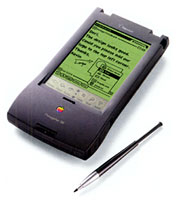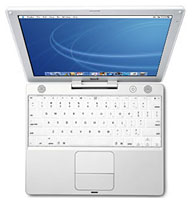Mac Musings
Newton 2004: A Digital Hub in the Palm of Your Hand
Daniel Knight - 2004.03.17
Although Apple considered the Newton a failure, those who use a Newton consider them a great success - and a lot of us still use them.
Any Newton is hopelessly outdated by today's standards. The CPU is slow, the screen doesn't support color, and they're not particularly easy to interface with modern computers. But they also have nice large screens, awesome battery life, and pretty impressive character recognition. Best of all, they just work.
As a Newton user and a longtime Mac user, I'd love to seen Apple rejoin the handheld computer market with a modern device that ties into iCal, the Address Book, iTunes, iPhoto, and other Mac essentials. It should also work with AppleWorks files and be able to display Word and Excel files.
 I
like my MessagePad 130 (so does
Adam Robert Guha - read his Newton:
Too Much, Too Early?). It's slow, but CPUs are faster today.
It's b&w, but color LCDs are a commodity these days. And it's
bulky, but by now Apple has learned to make 1" thin aluminum-clad
PowerBooks and the iPod mini.
I
like my MessagePad 130 (so does
Adam Robert Guha - read his Newton:
Too Much, Too Early?). It's slow, but CPUs are faster today.
It's b&w, but color LCDs are a commodity these days. And it's
bulky, but by now Apple has learned to make 1" thin aluminum-clad
PowerBooks and the iPod mini.
From a technological standpoint, there's no reason Apple couldn't make a worth successor to the Newton.
From a marketing standpoint, it's another issue entirely. The PDA market has grown, but few consider their Palms or Pocket PCs real field computers. Any new Newton should be designed as more than a data repository; it should be a real field machine.
The iPDA should be smaller than the Newton, maybe 10-20% in each dimension. The Newton MessagePad was a handful, and the world is populated by people with small hands - students among them. But it should also be larger than a PocketPC so it can be rugged, have a large display, and be harder to misplace.
I'd like to see a 1024 x 768 display, even if those pixels are pretty tiny. One company already makes a 640 x 480 2.5" LCD, so a 1024 x 768 screen that's maybe 7-8" on the diagonal should be doable.
It would have to include full-screen stylus input, just like the original Newton, but it should also have a cursor controller and a couple of buttons, maybe something like Nintendo perfected on the Gameboy. After all, a computer this small (or a PDA this large) could make a spectacular handheld game machine.
The screen should work in both a vertical and a horizontal orientation, and it should be as easily used by lefties as by the right-handed majority. There should also be a clear protective cover for the screen that could be easily and inexpensively replaced.
The iPDA should include Bluetooth and have a slot for AirPort Extreme. FireWire and USB 2.0 should be standard, along with a port for connecting to an external monitor. It should have a hard drive, either 2.5" or the same compact drive used in the full-sized iPod. Like the iPod, it should work in FireWire Disk Mode and sync with iTunes. A PC Card slot or slots for popular digicam memory cards might also be a nice touch.
We're pretty much looking at a reduced-size iBook with a touch screen and without a keyboard or optical drive - but both should be optional accessories. Maybe the keyboard could store underneath the iPDA and detach for use, using Bluetooth instead of wires. This would allow handheld use of the device without opening the keyboard.
The iPDA could function as an oversized iPod - just add headphones. It could be a great photo storage device for digital photographers, complete with iPhoto and a big screen to organize and edit their work. It could be a handheld computer that could run an LCD projector for PowerPoint and Keynote presentations.
And it would be a PDA that would run circles around anything else on the market.
It wouldn't need a whole lot of horsepower, maybe a low-end 700-800 MHz G3 or G4, or maybe a pair of 500-600 MHz G4s. Give it 256 MB of RAM and a slot for up to 1 GB more. Include video circuitry that supports Quartz Extreme and both mirroring and spanning with an external display.
If it uses a 2.5" hard drive, which would keep costs down while making it a bit larger, make sure high capacity and high RPM drives are available. Make it easy for Mac owners to update the OS in the iPDA with the device in FireWire Disk Mode.
Then prepare to market the heck out of it.
First, it's a real Mac running the Mac OS on a real PowerPC processor. Second, it's got the Newton's handwriting recognition (improved for the 21st century) and nearly its size. Third, it works with Macs and Windows, with iTunes and iPhoto, as a portable hard drive and as a handheld digital hub.
Add a battery-operated DVD drive, and you have your movies to go. Add a keyboard, and you have the best handheld field computer ever. Add headphones, and you have your tunes to go.
 Users think nothing of paying $300-400 for a
decent PocketPC with color, and they have a minuscule screen,
limited data storage, oddball processors, and a lightweight OS.
Music lovers readily pay $299 and up for a full-sized iPod. And Mac
users think a full-sized iBook is
a good deal at $999.
Users think nothing of paying $300-400 for a
decent PocketPC with color, and they have a minuscule screen,
limited data storage, oddball processors, and a lightweight OS.
Music lovers readily pay $299 and up for a full-sized iPod. And Mac
users think a full-sized iBook is
a good deal at $999.
Put all the pieces together, and I think Apple could come up with a device that combined the brilliance of the Newton with the best of the Mac in a $600 device (for the entry level model) that would sell to Mac users and Newton users. It would be attractive to those buying portable DVD players, iPods, and PDAs. And it could give Apple another way to grow their education market.
This could be Apple's next wild success, following in the footsteps of the iPod while also increasing the OS X base, a standout product worth a premium price because people see its true value.